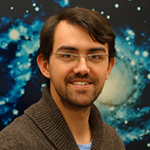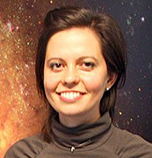Seminars are held at 4:00 PM on Tuesdays in Room F160
on the first floor of the Technological Institute (2145 Sheridan Road) unless otherwise noted
Fall Quarter 2015
| Date | Speaker / Seminar | Host | |
| Sept. 22 |  | Zhaohuan Zhu Transitional disks are protoplanetary disks with gaps and holes. Although young planets can lead to gaps and holes in disks, recent near-IR polarization imaging (e.g. SEEDS, VLT) and submm (e.g. SMA, ALMA) observations have posed several puzzles. Such as, dust and gas seems to decouple in these disks and the decoupling can occur non-axisymmetrically in disks. Spiral patterns are also discovered in these disks. To understand these new findings, I have carried out hydrodynamic and magnetohydrodynamic global simulations with young planets in disks. Moreover, both dust particle dynamics and non-ideal MHD effects have been considered for the first time. By comparing such realistic simulations with observations, I have constrained protoplanetary disk properties and revealed the early stage of planet formation. Finally, I will discuss the observational strategies to directly find young planets in protoplanetary disks and suggest that accreting circumplanetary disks could be the key to detect young planets directly. I will argue that current direct imaging observations may have already found some circumplanetary disk candidates and there are more to come. |
Sourav Chatterjee |
| Sept. 29 |  | Ryan Cooke The birth of the first stars arguably marks one of the most important physical and chemical transformations of the Universe. These stars kick-started reionization and synthesised the first metals. However, despite their impact, we still know very little about them. Even though no primordial star has yet been identified, we can start to understand their properties by studying the relative abundances of the elements that were made during their lives. In this talk, I will present the results from a suite of model calculations that follow the enrichment of the first stars. These minihalo models predict the chemical signature that is borne into the second generation of stars, and provide a new perspective on the formation of carbon-enhanced metal-poor stars. I will also present the latest results from my survey to find the most metal-poor damped Lyman-alpha galaxies (1/1000 of solar metallicity) at redshift z~3. I show that some of these systems may have been enriched solely by the first generation of stars. |
Claude-André Faucher-Giguère |
| Oct. 6 |  | Amaury Triaud Low mass stars, brown dwarfs and hot Jupiters have similar radii. For a fairly narrow size range (~0.7 to 2 Jupiter radii) Nature has produced objects covering nearly three orders of magnitude in mass (between 0.2 and 200 Jupiter masses). This is of particular importance for transit surveys which are mostly sensitive to size. Those same surveys are also heavily biased towards proximity to the central, most luminous object. This is how ground-based transit surveys have primarily found hot Jupiters. Those fascinating planets can at times be hotter and bigger than the smallest Hydrogen burning stars.
|
Yoram Lithwick |
| Oct. 13 |  |
Tony Piro Supernovae are amazing cosmic explosions where for a few weeks to months a single star can become as bright as a billion stars combined. Even though supernovae are crucial in a wide range of areas in astrophysics, from producing the elements to galactic evolution to measuring the accelerating expansion of our Universe, the actual progenitors are frustratingly elusive. This is now changing with surveys that are discovering supernovae earlier than ever and efforts to consolidate and follow-up these events. I will discuss theoretical work that utilizes these obsevations to measure fundamental quantities of the stars in their moments before death, such as their mass, radius, and properties of their circumstellar material. I will also present novel efforts to track down which stars end their lives as black holes through potential transient events and nucleosynthetic signatures. |
Francesca Valsecchi |
| Oct. 20 |  |
Thayne Currie Direct imaging/spectroscopy is the means by which we will eventually identify, confirm, and characterize a true Earth twin around a nearby star. While conventional adaptive optics instrumentation has restricted us to primarily imaging only superjovian-mass planets at wide separations, the new suite of dedicated extreme AO systems coupled with advanced post-processing techniques will soon reveal images and spectra for solar system-mass planets. In just one year of science operation, the new extreme AO system GPI has identified a bona fide Kuiper belt analogue to a young Sun-like star, imaged the first methane-rich and ~Jupiter-mass exoplanet, and now potentially has imaged only the second known multi-planet system. |
Fred Rasio |
| Oct. 27 |  |
Tim Brandt Advances in adaptive optics and infrared instrumentation have allowed us to see young exoplanets millions of times fainter than their host stars at separations corresponding to the outer Solar system. Large surveys, including one by the international SEEDS collaboration, have searched for massive planets around a total of about 1000 stars. As I will show, the results of these surveys suggest that we are approaching the contrasts and separations needed to see young planets formed by core-accretion. Now, simple cameras are being replaced by integral-field spectrographs, and adaptive optics systems are being dramatically upgraded. Instruments like the CHARIS integral-field spectrograph for the Subaru telescope will improve our sensitivity to faint exoplanets while simultaneously allowing us to characterize their atmospheres in much more detail. All of these upgrades, particularly the transition from images to spectra, bring new and unsolved challenges in data analysis. I will give an overview of these challenges and the techniques we are developing to overcome them. We are now planning a two-year CHARIS survey to begin in early 2017. It will obtain low-resolution spectra of young giant planets, and will search about 100-150 stars for faint companions at separations as small as 0.1--0.2 arcseconds. |
Vicky Kalogera |
| Nov. 3 |  |
Raffaella Margutti Stellar explosions are at the intersection of several critical areas of modern Astronomy: as probes of the early Universe, as electromagnetic signposts of gravitational wave and neutrino emitters, as laboratories for extreme physics. In this talk I present the recent results from my multi-wavelength effort designed to (i) constrain the stellar progenitors and their evolution in the years before the terminal explosion; (ii) shed light on the physical mechanism that enables only a small fraction of stellar explosions to harbor and launch a relativistic jet. By taking advantage from DISCOVERY -provided by observations of the transient sky- and DEEP-INSIGTH -that only a truly multi-wavelength perspective can offer-, I show how this study paves the way to the upcoming era of multi-messenger astronomy. |
Vicky Kalogera |
| Nov. 17 |  |
Maryam Modjaz Nature's two magnificent explosions, long-duration gamma-ray bursts
(GRBs) and stripped-envelope supernovae (SNe), are both products of
collapsing massive stars. Yet, over the last 15 years, we have not
determined the detailed make-up of the stellar progenitors of each kind
of explosion, nor the conditions that lead to each kind of explosion in
massive stripped stars. While long-duration GRBs emit relativistic jets
of high-energy radiation, stripped SNe are core-collapse explosions
whose massive progenitors have been stripped of their outer hydrogen and
helium envelopes. Understanding the progenitors of different kinds of
explosions impacts many fields of astrophysics, including using them as
cosmological tools.
|
Vicky Kalogera |
| Dec. 1 |  |
Yuan Li AGN feedback is widely considered the major heating source to prevent a classical cooling flow in the center of galaxy clusters. Numerical simulations have shown that momentum-driven AGN feedback can suppress cooling successfully and reproduce cluster properties generally in good agreement with the observations. However, exactly how the jet is coupled to the intra-cluster medium is still unclear. In this work, we study how much heating comes from shock waves, and how much from turbulent dissipation in a simulation where cooling isbalanced by AGN feedback. We also examine how the importance of different heatingprocesses changes as a function of time, distance to the center, and the thermal propertiesof the gas. |
Claude-André |
For more information, contact:
ciera@northwestern.edu
Past Astrophysics Seminars